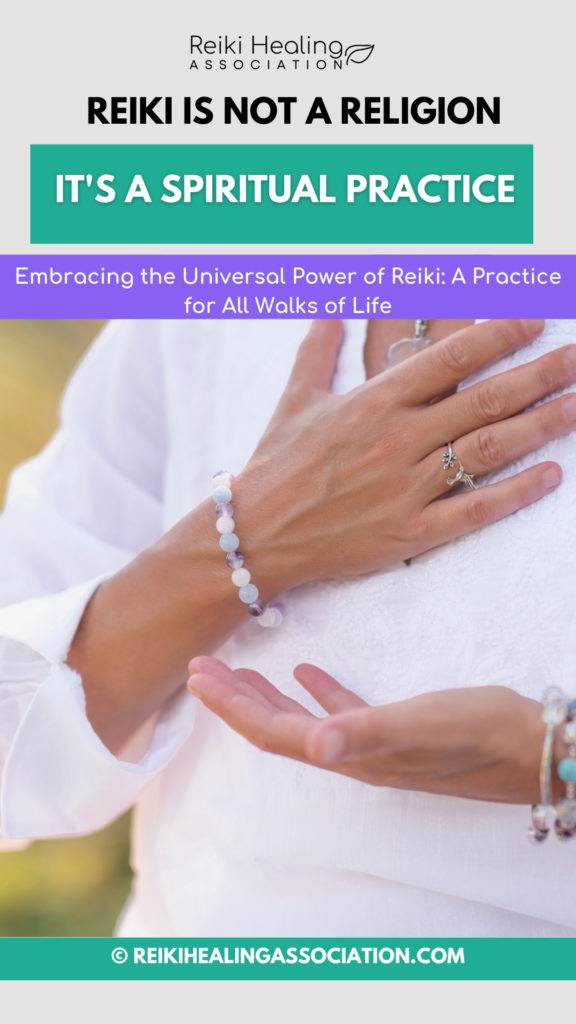
Reiki is not a Religion, it’s a spiritual practice 💚
Some people believe that Reiki is tied to a specific religious belief or that it involves spiritual rituals that align with a particular faith.
But Reiki is a spiritual practice, that is not tied to any specific religious belief system or religious affiliation. This means that people from various spiritual backgrounds, as well as those who identify as agnostic or atheist, can practice and benefit from Reiki. Certainty, the beauty of Reiki lies in its openness to all, making it a powerful tool anyone can use for reducing stress, promoting balance, and fostering overall well-being. There are no barriers to getting started with Reiki – just a willingness to learn for a qualified Reiki Teacher, and an open mind to explore a holistic approach to health and wellbeing.

Embracing the Universal Power of Reiki: A Practice for All Walks of Life
The practice of Reiki welcomes individuals from diverse backgrounds and belief systems, as it draws upon universal principles of energy, mindfulness and the power of setting intentions, which transcends religious boundaries. Like the more widely accepted practices of meditation or yoga, the focus of Reiki is to balance the flow of healthy energy around the mind, body and spirit to enhance overall wellbeing and help individuals feel more at peace. Just like other energy techniques like acupressure and massage, Reiki is used by many people with transformative effects on mental, emotional, and physical health.
And in the hustle and bustle of today’s society, where individuals are increasingly recognizing the need for holistic approaches to effectively manage chronic stress, alleviate pain, and enhance overall well-being, Reiki, provides a timeless and adaptable practice that can resonate with people from all walks of life and from all faith and belief systems.
Let’s look at the universal principles that Reiki draws upon:
- Balancing Energy for Wellbeing: Reiki is gentle practice rooted in ancient energy traditions, that works by channelling the natural, universal life energy that flows through every living being for the purpose of deep relaxation. By tuning into to this universal energy which we all possess, Reiki practitioners aim to harmonize and balance the energies within themselves and others. Reiki actively works to balance the energy flowing around the body, promoting a state of equilibrium and vitality. In this state of health, the body’s inbuilt healing systems are able to function better and immunity is strengthened.
- Mindfulness: Mindfulness is another key element that Reiki incorporates, encouraging individuals to be fully present in the moment. In today’s fast-paced world, characterized by constant distractions and the relentless demands of modern life, cultivating mindfulness through Reiki emerges as a potent antidote to the pervasive issue of chronic stress and anxiety. Through mindful awareness, individuals can develop a deeper connection with their own thoughts, emotions, and the world around them. This heightened consciousness enables them to navigate their internal landscapes with greater clarity and peace. By being fully present, Reiki practitioners learn to observe their experiences without judgment, creating a space for acceptance and self-compassion. Whether faced with professional demands, interpersonal relationships, or personal struggles, the mindfulness cultivated through Reiki serves as a compass, offering a steady anchor in the midst of life’s uncertainties.
- Intention: Intention holds a pivotal role in the practice of Reiki, as practitioners harness the transformative power of positive intentions to channel the universal life energy for healing and balance. At the heart of this principle lies the profound recognition that our thoughts and intentions have a tangible impact on the energy that flows within and around us. Practitioners set positive intentions during sessions to guide the flow of energy towards healing and balance. Similar to the way the Law of Attraction emphasizes the power of intention and the things we say, to attract desired outcomes into our lives.
- Oneness: Reiki also emphasizes the principle of oneness, recognizing the interconnectedness of all living things. Practitioners understand that their energy is intricately linked with the universal life force and this perspective fosters a sense of unity and compassion, encouraging practitioners to approach themselves and others with empathy and understanding. The practice instils a deep sense of gratitude for the interconnected web of life, promoting an attitude of thankfulness for the energy that sustains us all.
- Love: Love, as a universal principle, is woven into the fabric of Reiki. The practice encourages individuals to approach life with an open heart and to radiate love and compassion to themselves and others. This loving energy becomes a powerful force for healing and transformation, creating a positive ripple effect in the practitioner’s life and the world around them.
Reiki Sceptics: How to talk about Reiki to people who are sceptical of energy healing
Unfortunately, there are a lot of misconceptions and stereotypes surrounding the practice of Reiki, which has led to the circulation of a lot of myths around what Reiki is and who should be involved in this practice. Whilst Reiki is now practice worldwide and even incorporated into health care settings, it still faces persistent misunderstandings that hinder its widespread acceptance.
In some areas of the world, Reiki is less understood or accepted, which can make it difficult for Reiki Practitioners who are eager to teach other people about its positive benefits. And whilst it is not the job of the Reiki Practitioner to convince anyone of the efficacy of Reiki, bridging the gap of understanding can contribute to a more open and inclusive dialogue.
Here are some helpful strategies for Reiki Practitioners facing challenges in areas where Reiki may be less understood or accepted:
- First-hand experience: Unlike more physical practices such as massage or acupressure, Reiki involves the channelling of energy through light touch or hands hovering slightly above the body. This subtlety, while powerful, can sometimes be misunderstood or overlooked. That is why the best way to understand Reiki is to experience it first-hand, if someone is willing to give something new a try! Providing introductory sessions or workshop where people can experience Reiki for themselves, is a great way to address concerns and dispel myths. You might find that once people experience the benefits first-hand, they become more open to understanding Reiki in its traditional form.
- Consider the terminology you use: Its normal to be slightly cautious about things we don’t know much about. So when you are describing Reiki it is helpful to use terminology and references that are more broadly understood and accepted and less likely to be misinterpreted. For example, many people refer to Reiki as simply a hands-on energy balancing technique designed to promote relaxation, reduce stress, and enhance overall well-being. Emphasizing its adaptability and potential synergies with more mainstream practices like meditation and yoga, can highlight the unique contributions Reiki can make to an individual’s overall health and well-being.
- Shift the Spotlight to Benefits: Emphasizing the tangible advantages that Reiki offers, placing particular emphasis on stress reduction, relaxation, and the enhancement of overall well-being, is a great way to capture the attention of individuals who may be new to or sceptical about the practice. Some individuals may become more open to holistic practices over time as they witness positive experiences within their social circles or as they undergo personal transformations.
- Science and Reiki: While Reiki’s mechanisms may not be fully understood by conventional Western medicine, it’s essential to recognize that many holistic practices are gaining scientific interest and validation. Research on energy healing, including Reiki, continues to explore its potential benefits, making it more accessible and acceptable to a broader audience. Integrate scientific explanations where possible to underscore the evidence-based aspects of Reiki’s positive effects. For instance, stress reduction through Reiki has been associated with physiological changes, such as decreased heart rate and cortisol levels. By aligning the benefits with established scientific principles, you provide a bridge between traditional wisdom and contemporary understanding.
- Personalize Success Stories: Share personal testimonials and success stories that highlight the transformative impact of Reiki on individuals’ lives. Real-life accounts resonate more deeply with sceptics, offering relatable narratives that showcase the practical benefits and potential life-changing outcomes of engaging with Reiki.
- Complementary Practices: It is important to emphasize that Reiki is not a replacement for conventional medical care but a complementary practice that aligns with and supports various healthcare modalities. You should always highlight its collaborative nature, showcasing how it can work synergistically with other wellness practices to enhance overall health outcomes.
- Cultivate Professional Collaborations: Foster partnerships with healthcare professionals and wellness experts to reinforce Reiki’s position as a valuable contributor to holistic health. Collaboration with other respected practitioners can lend credibility and broaden acceptance within the broader wellness community.

While Reiki Practitioners should never aim to convince or force acceptance around Reiki, their efforts in education, collaboration, and community engagement can contribute to a more informed and open-minded perception of Reiki within less receptive areas. By focusing on demystifying the practice and highlighting its potential benefits, practitioners can play a role in breaking down barriers and fostering a more inclusive dialogue about holistic well-being.
Remember, the goal is to make this healing practice accessible and inviting to a wider audience, while respecting local sensitivities and beliefs. You should always respect someone’s choices and acknowledge each person’s autonomy in choosing the wellness practices that resonate with them, and never pressure or insist on Reiki treatments.
It’s essential to recognize that everyone has their unique beliefs, comfort levels, and perspectives on holistic practices. So please don’t take it personally if someone is not open to Reiki.
Usually for every person not willing to give Reiki a try, there are always many people more who are ready to explore it 💚 Celebrate the positive connections you make with individuals who resonate with the practice. By fostering an open and inclusive environment, you contribute to a positive and supportive community where those who are ready to explore Reiki can do so willingly and authentically.
Best of luck with your practice! 🙏
Share your thoughts in the comment box below!
And for more Reiki resources, be sure to connect with the Reiki Healing Association on Instagram, where we post daily Reiki inspiration and advice for healing and growth as a Reiki Practitioner or Reiki-enthusiast! And don’t forget to follow us on Pinterest, where we are pinning positive affirmations and empowering quotes every single day.
More Articles For You
- Reiki Room Inspiration
- Sending Reiki Distantly
- Reiki Symbols Infographic
- Animal Reiki Tips
- Getting to Know Mikao Usui – the Founder of Reiki
- Just for today I will be Grateful – How to Live Each Day with Gratitude
- Setting Up Your Week For Powerful Reiki Sessions
Have you read the Universal Life Magazine yet? Subscribe now for more Reiki inspiration.


